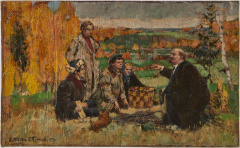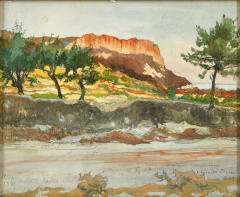Art Investment
Kravchenko Aleksey Iliich
1889–1940
БИОГРАФИЯ
KRAVCHENKO Alexey Ilyich
Graphic artist, painter, scene-designer
Alexey Kravchenko was born to a peasant family. He studied in the religious school in Saratov (1896–1900), in Moscow School of painting, sculpture and architecture (MUZhVZ; 1904–1905, 1907–1910) under the guidance of S. V. Ivanov, K. A. Korovin, V. A. Serov, A. E. Arkhipov, A. M. Vasnetsov, and in the School of Simon Hollósy in Munich (1906). In 1908 Kravchenko was awarded the Levitan Prize for his landscape In Ural Village.
The artist lived in Moscow (till 1918, since 1922), in Saratov (1918–1922). In 1908–1910 Kravchenko travelled on the rivers Volga, Sukhona, Northern Dvina; he visited Ural and the Crimea. In 1910–1911 he made a trip to Italy. In 1912–1913 he worked near Moscow, drew sketches in Sukhanovo and in Zvenigorod. The artist spent summer months of 1913 in Tarusa; there he made acquaintance with engraver I. N. Pavlov; under his guidance Kravchenko began to study linocut technique. In 1914 Kravchenko visited India and Ceylon (together with sculptor V. A. Vatagin) by the order of the Imperial Academy of Arts (IAKh).
In 1915 Kravchenko was mobilized to the south-west front as an artist and photojournalist; in 1916 he was demobilized. After the revolution of 1917, Kravchenko worked in the art section under the Department for Culture and Education (Kultprosvet) at the Soviet of workers, peasants and soldiers deputies. He was also a member of Moscow Union of painters and graphic artists. Kravchenko was engaged in design and agitation posters for revolution holidays.
In 1918 Kravchenko was sent to Saratov by the National commissariat of education (Narkompros) in order to organize province committee of fine arts. He was one of the founders of the State Free Art Studios in Saratov, where he was a dean of the faculty of graphic arts. Kravchenko headed the Radishchev Art Museum and the art section under the Department of Fine Arts at the Soviet of People’s Education.
In 1922 Kravchenko returned to Moscow. In the same year the artist was elected member of the Academy of Fine Arts. In 1925–1926 he travelled through Italy and France. In 1929 he was sent on a trip to New York by the All-Union Society for cultural relations with foreign countries (VOKS) in order to organize art section of the USSR pavilion at the International exhibition of industrial art. In 1930s Kravchenko made several trips through the Soviet Union; he visited regions of industrial construction of 1930s (Dneprostroy), visited Estonia, North Ossetia, Georgia, Armenia, Azerbaijan, the Black Sea coast; he also travelled on Volga River.
Kravchenko worked as a graphic artist (etching, woodcut, and linocut), he also used tempera and watercolour techniques. The artist painted landscapes, portraits, nudes; he was engaged in book illustration and bookplates. The most significant works are landscape series Russian Landscape (1906–1916), India (1913–1914), Italy (1910–1911, 1925–1926), Paris (1926), The Caucasus (1934); the industrial and genre series Woman’s life in past and present (1928), V. I. Lenin’s Mausoleum (1930–1933), Dneprostroy (1930–1931). Kravchenko illustrated books Meister Floh by E. T. A. Hoffmann (1922), The Cricket on the Hearth by Ch. Dickens (1923), Portrait by N. V. Gogol (1923), Stories by St. Zweig (1934), Egyptian Nights (1934) and Little Tragedies (1936–1937) by A. S. Pushkin, Notre Dane de Paris by V. Hugo (1940), and the works by H. de Balzac, M. I. Sholokhov, A. V. Chayanov, M. L. Leonov and others.
Kravchenko was a member and exhibitor of Moscow Association of Artists (MTKh) in 1913–1922 (with intervals), the society Four Arts in 1925–1929. He showed his works at the exhibitions of the Union of Russian Artists (SRKh; 1922–1923), the group Mir Iskusstva (“World of Art”; 1924), the society Bytie (“Being” 1925); the jubilee exhibitions Engraving of the USSR for 10 years, Russian Drawing for 10 years of October Revolution, Graphic Art in the USSR, Russian xylography for 10 years (all — 1927), the Exhibition of works of Art for the 10th anniversary of the October Revolution (1928), the exhibition Artists of the RSFSR for 15 years (1933–1934) in Moscow and Leningrad and many others. Kravchenko also participated in many international exhibitions and exhibitions of Soviet art abroad, including the First Russian Art Exhibition in Berlin (1922); the 14th, 17th, 18th International art exhibitions in Venice (1924, 1930, 1932); the International exhibition of fine and decorative arts in Paris (1925, Grand Prix); the exhibition Art of the Book in Leipzig (1927) and in Paris (1931); the 3rd exhibition of woodcut in Paris (1928); the exhibitions of Soviet art in the USA (travelling exhibition, 1924–1925), Tokyo (1927), London (1928), New York, Amsterdam (both — 1929), Vienna, Berlin, Stockholm (all — 1930), Prague, Zurich, Johannesburg (all — 1931), Koenigsberg (1932) and others.
Since 1932 Kravchenko was a member of the Union of Artists of the USSR, member of the section of graphic arts and member of the board at Moscow Regional Union of Soviet Artists (MOSSKh). Since 1932 Kravchenko was a member of the Council of the State Tretyakov Gallery.
The artist taught in Moscow State Academic Art Institute (MGKhI) in 1935–1940 (professor).
Kravchenko was buried in the Novodevichy cemetery in Moscow.
Alexey Kravchenko is one of the most significant masters of graphic arts of our country at the first half of the 20th century. In his early works the artist was close to the group Mir Iskusstva (“World of Art”); he was interested in symbolism. His works of that period (1910s) are characterized by romantic nostalgia, chamber manner of painting, and fine lines and forms. After the October revolution Kravchenko combined aesthetic of Mir Iskusstva with the style of Social realism. He painted on history, revolution and industry themes. His works were characterized by monumental manner, energetic strokes and dynamic composition (the cycle Dneprostroy). The artist’s landscapes series of 1920s–1930s, on the contrary, were notable for soft manner of painting and lyricism.
Works by Alexey Kravchenko are in many museum collections, including the State Tretyakov Gallery, the State Russian Museum, the Pushkin State Museum of Fine Arts and others.
Новости - Auctions
Торги «Антиквариума» 28 июля. Краткие итоги
03.08.2018Очередной аукцион #всёпорублю в «Литфонде» принес почти 4,5 млн.руб.
25.07.2018«Русская Эмаль» торжественно закрывает сезон и уходит в отпуск
24.07.2018Краткие итоги сороковых живописных торгов «Кабинета»
16.07.2018Коротко о главном: итоги аукциона 28 июня в «Литфонде»
03.07.2018Торги 27 июня в «Литфонде» для самых терпеливых и настойчивых
03.07.2018
Услуги ARTinvestment
Арт-консалтинг
Индивидуальные консультации от опытных искусствоведов по любым вопросам в сфере искусства
Составление Инвестиционного Портфеля
Подбор предметов искусства для инвестирования под любую инвестиционную стратегию
Индивидуальная оценка
Наши эксперты проведут профессиональную оценку вашего предмета искусства, учитывая его состояние, авторство, историю и другие факторы
Проведенных аукционов
Зарегистрированных пользователей на аукционе
Записей в базе
Художников в базе
Auction sale in AI Auction

БУРЛЮК Давид Давидович (1882–1967) Катание в санях. 1966 (20 × 25 см)
сделать ставку
ЮКИН Владимир Яковлевич (1920–2000), БРИТОВ Ким Николаевич (1925–2010) В.И. Ленин с детьми (эскиз). 1956 (35 × 57 см)
сделать ставку
БЕНУА Александр Николаевич (1870–1960) В окрестностях Кассиса. 1929 (26,4 × 32 см в свету)
сделать ставку